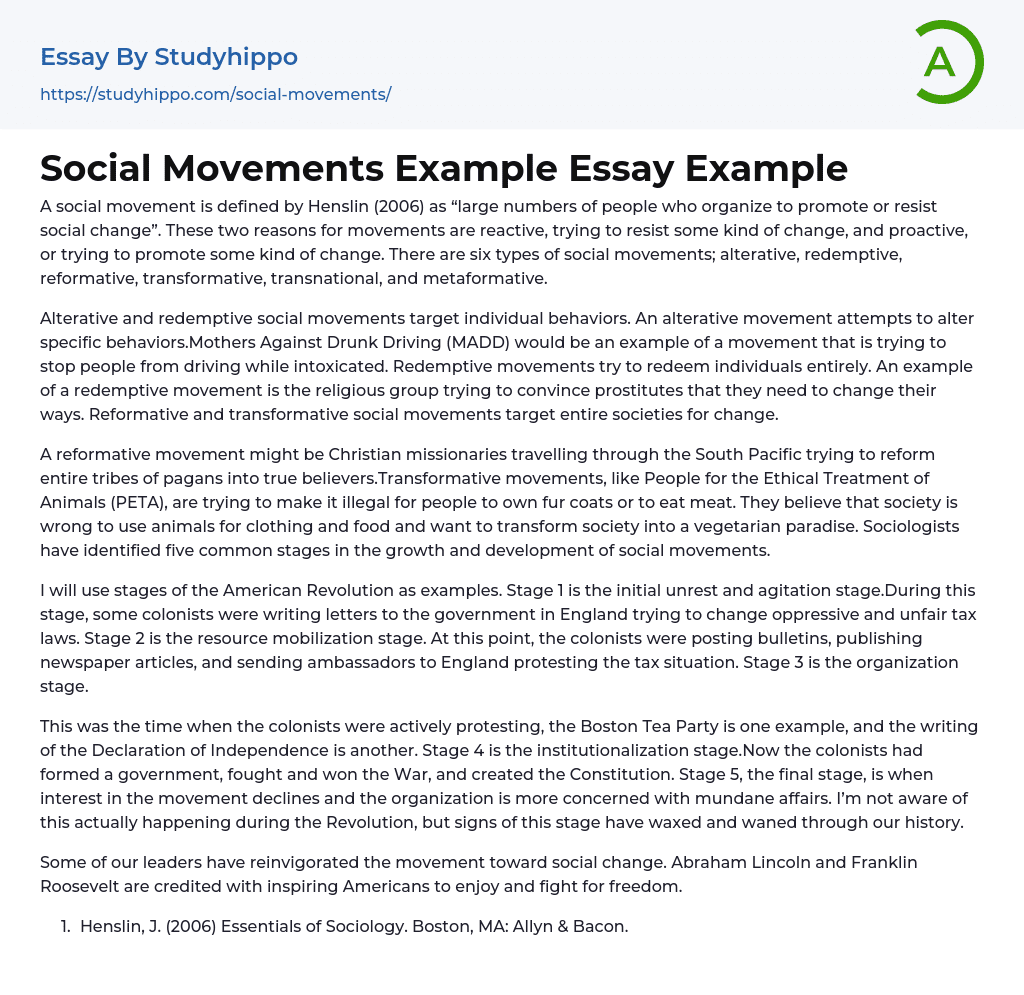A social movement is defined by Henslin (2006) as “large numbers of people who organize to promote or resist social change”. These two reasons for movements are reactive, trying to resist some kind of change, and proactive, or trying to promote some kind of change. There are six types of social movements; alterative, redemptive, reformative, transformative, transnational, and metaformative.
Alterative and redemptive social movements target individual behaviors. An alterative movement attempts to alter specific behaviors.Mothers Against Drunk Driving (MADD) would be an example of a movement that is trying to stop people from driving while intoxicated. Redemptive movements try to redeem individuals entirely. An example of a redemptive movement is the religious group trying to convince prostitutes that they need to change their ways. Reformative and transformative social movements target entire societies for change.
...A reformative movement might be Christian missionaries travelling through the South Pacific trying to reform entire tribes of pagans into true believers.Transformative movements, like People for the Ethical Treatment of Animals (PETA), are trying to make it illegal for people to own fur coats or to eat meat. They believe that society is wrong to use animals for clothing and food and want to transform society into a vegetarian paradise. Sociologists have identified five common stages in the growth and development of social movements.
I will use stages of the American Revolution as examples. Stage 1 is the initial unrest and agitation stage.During this stage, some colonists were writing letters to the government in England trying to change oppressive and unfair tax laws. Stage 2 is the resource mobilization stage. At this point, the colonists were posting bulletins, publishing newspaper articles, and sending ambassador
to England protesting the tax situation. Stage 3 is the organization stage.
This was the time when the colonists were actively protesting, the Boston Tea Party is one example, and the writing of the Declaration of Independence is another. Stage 4 is the institutionalization stage.Now the colonists had formed a government, fought and won the War, and created the Constitution. Stage 5, the final stage, is when interest in the movement declines and the organization is more concerned with mundane affairs. I’m not aware of this actually happening during the Revolution, but signs of this stage have waxed and waned through our history.
Some of our leaders have reinvigorated the movement toward social change. Abraham Lincoln and Franklin Roosevelt are credited with inspiring Americans to enjoy and fight for freedom.
- Henslin, J. (2006) Essentials of Sociology. Boston, MA: Allyn & Bacon.
- Federal government essays
- Armed Forces essays
- Confederate States Of America essays
- Federal Government Of The United States essays
- Fourteenth Amendment To The United States Constitution essays
- Governance essays
- Parliament essays
- Politics essays
- Jurisdiction essays
- Bureaucracy essays
- Separation Of Powers essays
- Congress essays
- President essays
- United States Congress essays
- Non-Commissioned Officer essays
- Appeal essays
- Revenge essays
- Corporate Governance essays
- Public Service essays
- Income Tax essays
- Supply essays
- Red Cross essays
- Democracy essays
- State essays
- Liberty essays
- Absolutism essays
- Reform essays
- Republic essays
- John Marshall essays
- Bourgeoisie essays
- Developed Country essays
- Elections essays
- International Relations essays
- Left-Wing Politics essays
- Monarchy essays
- Political Corruption essays
- Political Party essays
- Political Science essays
- Sovereign State essays
- United Nations essays
- World Trade Organization essays
- Contras essays
- Dictatorship essays
- Foreign policy essays
- Monarch essays
- Corruption essays
- Foreign essays
- Democratic Party essays
- European Union essays
- President Of The United States essays




